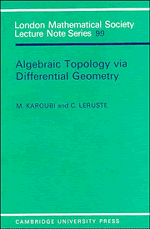Book contents
- Frontmatter
- Contents
- Introduction
- I Algebraic preliminaries
- II Differential forms on an open subset of Rn
- III Differentiable manifolds
- IV De Rham cohomology of differentiable manifolds
- V Computing cohomology
- VI Poincaré duality – Lefschetz' theorem
- Appendix A Stokes' theorem
- Appendix B Chern character and non-commutative De Rham cohomology
- Bibliography
- Index
- Frontmatter
- Contents
- Introduction
- I Algebraic preliminaries
- II Differential forms on an open subset of Rn
- III Differentiable manifolds
- IV De Rham cohomology of differentiable manifolds
- V Computing cohomology
- VI Poincaré duality – Lefschetz' theorem
- Appendix A Stokes' theorem
- Appendix B Chern character and non-commutative De Rham cohomology
- Bibliography
- Index
Summary
There are several ways of presenting Algebraic Topology: singular homology and cohomology, homotopy theory, K-theory, cobordism, etc. The one we have chosen is based on the De Rham cohomology of differentiable manifolds.
The advantages of this presentation are many: an algebraic formalism reduced to its minimum (tensor calculus, exterior algebra); a pleasant and natural multiplicative structure for the cohomology; self-contained proofs without reference to the literature. Another advantage lies in the kind of mathematical culture – varied and not too specialised – which is necessary for the understanding of these notes: they therefore form a course accessible to students in their final year of undergraduate studies.
On the other hand, this approach clearly has its limits in so far as the torsion phenomena of cohomology are not dealt with (though this can be achieved through the ‘modern’ presentation of De Rham cohomology due to Sullivan, Grothendieck and Miller: see the paper by H. Cartan [3]. Similarly, homotopy theory is virtually absent. So this course should be seen as a first step towards Algebraic Topology and the geometry of manifolds. For a deeper study, we refer the Reader to, e.g., the following: [6], [8], [12], [15], [16], [17], [13], [18].
With the exception of the two appendices, this book was first published, in French, by the Publications mathématiques de l'Université Paris VII, in 1982. Stokes' theorem, being a classic related to the main topic – and indeed hinted at in the text (VI.1.22 (ii)) – was included in full as Appendix A.
Information
- Type
- Chapter
- Information
- Algebraic Topology via Differential Geometry , pp. ix - xPublisher: Cambridge University PressPrint publication year: 1988
